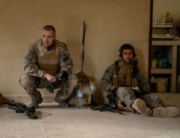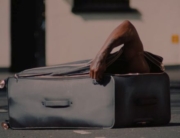

In Elizabeth Lo’s Stray, exquisite close-ups of rugged, curious-eyed dogs offer a glimpse into the soul of man’s best friend. This concise and wholesome documentary tracks the itinerant lives of several street dogs as they wander Istanbul in search of food, shelter, and companionship. The result is a minimalist and microcosmic portrait of contemporary urban life and the uncertainties facing its inhabitants, Man and Dog.
Shot in true slice-of-life fashion, Lo’s camera is at times as much astray as the dogs she follows, her lens often wandering off into the hectic milieus that the canines reside in. Our four-legged protagonists encounter an array of people, some offering leftover bones to chew on, others shooing them away and threatening to have them killed. The canines’ precarity is mirrored in human form through their encounter with three homeless Syrian refugees: Jamil, Halil, and Ali. They are also itinerant and at the mercy of an increasingly exclusionary urban terrain. They take some of the dogs in, sleep with them, and act as companions in their own right. In one scene, the three young men and the dogs find shelter and squat in an unoccupied construction site. Their slumber is interrupted when a security guard finds them and kicks them out onto the street.
But Lo’s film is not all doom-and-gloom commentary. These scenes are balanced out by other caring human interactions that reveal the uniquely harmonious relationship between street dogs and the people of Istanbul. The city is noteworthy for its treatment of stray animals. After decades of mass extermination campaigns against stray dogs in Turkey, a series of legislative changes and public initiatives, catalyzed by animal rights groups and mass protests, were pushed to restore dignity to these independent beings. Laws in many Turkish municipalities now have mass vaccination campaigns for stray animals as well as harsher penalties for inhumane treatment. From this perspective, it is easy to see why Lo chose Istanbul as a microcosm for the ways in which the struggles of dog and man intersect.
On a technical scale, the film also proves to be quite an accomplishment. The camera is perfectly in balance with the dogs’ field of vision and simulates beautifully their inquisitive and attentive point of view. Low angled shots are also coupled with sound designer Ernst Karel’s meticulous capturing of the diegetic rhythms of the urban everyday—the hymns of the Islamic call to prayer, frustrated couples conversing about their love life, amused garbage men making their nightly rounds, tourists, partygoers, and traffic ambience enhance the scenery.
For dog lovers, Stray provides ample heart melting moments in its attentive close-ups of the resilient canines and their routines, but it also has wider appeal. Lo’s sympathetic eye, working in tandem with a culturally lush city and a talented sound crew, captures a delicate portrait of modernity, where mutual aid and companionship often becomes a necessity and crosses cultures and even species.
















Leave A Comment